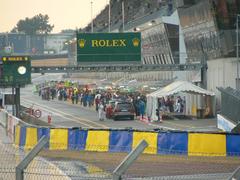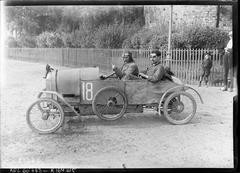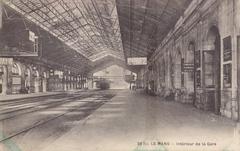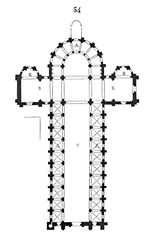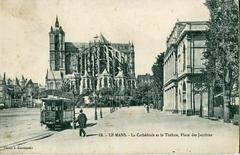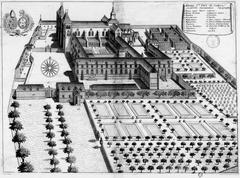
Gallo-Roman Walls of Le Mans: Visiting Hours, Tickets, and Historical Sites Guide
Date: 03/07/2025
Introduction
The Gallo-Roman Walls of Le Mans rise at the heart of the city, bearing witness to over 1,700 years of history. These imposing fortifications, constructed in the late 3rd century CE, are among the best-preserved Roman urban walls in Europe. Built to protect the ancient city of Vindinum, now Le Mans, they embody the ingenuity of Roman engineering and the evolving identity of the city through the ages. Today, they stand not only as a monument to the past but as an integral part of Le Mans’ urban and cultural landscape, drawing visitors year-round to explore their remarkable structure and the vibrant history they enclose (Ville du Mans; France.fr).
This guide offers essential information for planning your visit, including historical context, architectural highlights, visiting hours, ticketing, accessibility tips, and nearby attractions. Whether you are a history buff, an architecture enthusiast, or a traveler seeking an authentic experience, the Gallo-Roman Walls of Le Mans promise a fascinating journey through time (INRAP; Mary Anne’s France).
Table of Contents
- Origins and Construction
- Architectural Features
- Historical Evolution
- Archaeological Insights
- Visiting Information: Hours, Tickets, Accessibility
- Notable Points of Interest
- Cultural Events and Local Identity
- FAQs
- Travel Tips and Nearby Attractions
- Conclusion
Origins and Construction
The Gallo-Roman Walls were erected during the late 3rd century CE, a turbulent era known as the Crisis of the Third Century, which threatened Roman cities across Gaul. Le Mans, then Vindinum, was the capital of the Aulerci Cenomani tribe and required formidable defenses against both political instability and external invasions (Ville du Mans).
Using local sandstone, flint, and bricks, builders constructed a circuit of walls extending approximately 1,300 meters and enclosing an area of about 9 hectares. The walls average 8–9 meters in height and up to 12 meters at their tallest, with a thickness varying between 2 and 4 meters. Twenty-six semi-circular towers, spaced every 30–40 meters, strengthened the fortifications, eleven of which remain visible today (France.fr; Le Mans Tourisme).
Architectural Features
The most striking element of the Le Mans walls is the use of “opus mixtum”: alternating bands of red brick and white stone, forming intricate polychrome patterns. The towers and segments of the wall are decorated with geometric motifs—diamonds, chevrons, lozenges, and even swastikas—combining defensive utility with visual grandeur (Patrimoine-Histoire; Atlas Obscura).
The walls feature a rubble core faced with finely cut stone and brick, while the outward-projecting towers allowed defenders to cover the approaches with flanking fire. Monumental gates such as the Porte de la Couture and Porte Saint-Pierre regulated access, integrating the walls with the city’s urban fabric (Le Mans City).
Historical Evolution
Middle Ages to Modern Times
After the collapse of Roman authority in the 5th century, the walls remained crucial for defense, sheltering the population during Viking raids and conflicts such as the Hundred Years’ War. Over the centuries, the city’s footprint contracted within the enclosure, and medieval builders adapted the fortifications to suit new defensive strategies, often integrating them into homes and shops—a factor that aided their preservation (francethisway.com; wikipedia).
From the 19th century onwards, archaeological interest and heritage protection led to systematic restoration and study. The walls were listed as a Monument Historique in 1862 (Ministère de la Culture).
Archaeological Insights
Excavations have revealed original plaster, pigments, and repair works. Research suggests the decorative motifs may have held symbolic or protective significance, reflecting both Roman and local artistic traditions (INRAP).
Visiting Information: Hours, Tickets, and Accessibility
Visiting Hours:
The Gallo-Roman Walls are open to the public year-round, as they are integrated into the city’s pedestrian spaces and riverside gardens. The best times to visit are during daylight hours (9:00 AM–6:00 PM), but some sections are accessible 24/7.
Tickets:
No ticket is required to see the walls themselves. Guided tours, available during summer and for special exhibitions, are bookable through Le Mans Tourisme and typically cost €5–€10.
Guided Tours:
English-language tours are offered in summer (June–August), generally on Wednesdays at 3 pm. Tickets are €6 per person (Mary Anne’s France).
Accessibility:
Most walkways are paved and suitable for visitors with limited mobility, though cobbled streets and stairs may present challenges. Contact the tourist office for specific accommodations.
Travel Tips:
- Wear comfortable shoes for uneven surfaces.
- Bring a camera, especially for evening visits during light festivals.
- Obtain a map from the tourist office (La Maison du Pilier-Rouge, 41-43 Grande Rue).
Notable Points of Interest
- Porte des Jacobins: Well-preserved towers and brickwork.
- Rue des Fossés-Saint-Pierre: Close-up views of polychrome masonry.
- Place des Jacobins: Panoramic perspectives of the walls and city.
- Cité Plantagenêt: Medieval quarter with half-timbered houses and Renaissance mansions.
- Saint-Julien Cathedral: Adjacent Romanesque-Gothic cathedral.
Interpretive panels and digital resources are available throughout the site (Le Mans Tourisme).
Cultural Events and Local Identity
The Gallo-Roman Walls are central to Le Mans’ cultural life. Each summer, “La Nuit des Chimères” projects light shows onto the ancient masonry, attracting over 150,000 visitors and transforming the walls into a canvas for contemporary art (Sarthe Tourism). The event blends history with creativity, featuring motifs inspired by local legends, literary works, and the city’s Roman and medieval heritage.
The walls also serve as a source of community pride, symbolizing resilience and continuity for the citizens of Le Mans.
Frequently Asked Questions (FAQ)
Do I need a ticket to visit the walls?
No, the walls are free and open to the public year-round.
Are guided tours available?
Yes, guided tours (including English-language options) are available via the tourist office during the summer and for groups year-round.
Are the walls accessible for people with limited mobility?
Many sections are accessible, though some medieval streets and towers may be challenging.
What’s the best time to visit?
Daytime for architectural details; evenings in July–September for the light festival.
What else is nearby?
Saint-Julien Cathedral, Cité Plantagenêt, Carré Plantagenêt Museum, and the Musée de Tessé are all within easy walking distance.
Travel Tips and Nearby Attractions
-
Getting There:
- TGV from Paris Montparnasse to Le Mans (56 min) (Mary Anne’s France).
- By car: 2.5 hours from Paris.
- Local buses and trams operate daily.
-
Where to Stay:
- Stay in the old town for best access (e.g., Maison Saint-Pierre).
-
Cultural Layering:
- Experience the city’s Roman, medieval, and Renaissance layers by exploring the Cité Plantagenêt and participating in local festivals.
-
Safety:
- Le Mans is a safe city; standard precautions apply.
Conclusion
The Gallo-Roman Walls of Le Mans offer an unparalleled journey through the city’s Roman, medieval, and modern history. Their exceptional preservation, decorative artistry, and integration into the living city set them apart as both a monument and a vibrant cultural hub. Free public access, engaging guided tours, and seasonal light festivals ensure a rich and inclusive experience for all visitors. As Le Mans pursues UNESCO World Heritage recognition, the walls remain a testament to the enduring legacy of Roman engineering and community spirit (France.fr; Sarthe Tourism; Le Mans Tourisme; INRAP).
Plan your visit to Le Mans and immerse yourself in a story that has shaped the city for centuries.



